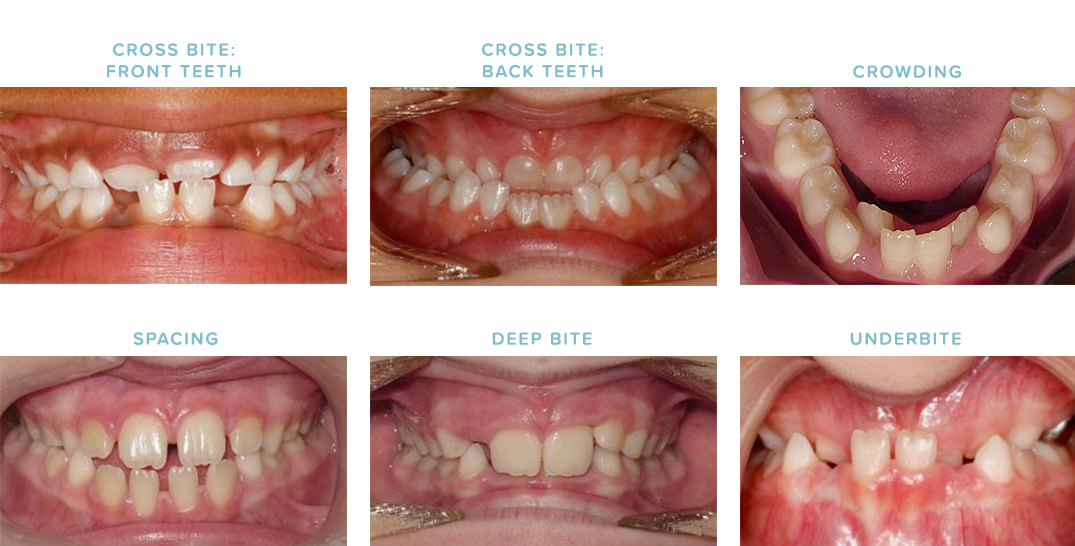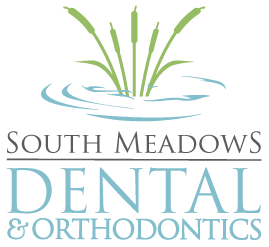Timing is everything! When it comes to children, keeping an eye on dental and skeletal development is important. Appropriate treatment at the right time benefits your child’s overall orthodontic success. The American Association of Orthodontists recommends children visit an orthodontic specialist by age 7. This way, Dr. Meagan Struby can check to see if your child’s teeth and jawbones have a normal growth pattern or if she needs to intervene with limited orthodontic treatment.
How Do I Know If I or My Child Needs Orthodontics?
You or your child’s dentist may notice “bad bites” like those illustrated below.
Concerns like thumb-sucking, airway issues, speech problems, and early loss of teeth should also be evaluated. These can be signs that you or your child can benefit from orthodontics.
How Does Early Treatment Work?
If early treatment (also known as Phase One treatment) is recommended, Dr. Meagan Struby can guide the growth of the jaw and incoming permanent teeth while also correcting poorly-positioned teeth that have already come in. There are a variety of tools and appliances that are used in early orthodontic care. These include:
- Expanders
- Limited braces
- Space maintainers
- Jaw positioning appliances
- Headgears
- Retainers
WHAT appliances ARE USED IN ORTHODONTICS?
There are many different tools and appliances that are used in orthodontic care. These include:
- Braces: This is the most common type of appliance used to shift the teeth for a straighter smile. These are made of bands, wires, and brackets. These are adjusted on a monthly basis for gradual improvement.
- Fixed Space Maintainers: These are used to help keep space open for a permanent tooth to grow in if a baby tooth is lost prematurely.
- Aligners: These are alternatives to traditional braces. These aligners are typically made of a clear plastic that is used to gradually straighten the teeth. These are removable appliances that are typically used by adults who want a straighter smile.
- Jaw Repositioning Appliances: This type of appliance is used to reposition the jaw so it closes properly. This can be used for patients with temporomandibular disorder.
- Lip and Cheek Bumpers: If the lips or cheeks are putting pressure on the teeth, these bumpers can help alleviate pressure by keeping the lips and cheeks away.
- Palatal Expander: This is used to widen the jaw arch. It is put on the roof of the mouth and applies pressure to open up the palate.
- Retainers: These appliances are used to prevent shifting of the teeth.
- Headgear: This appliance slows down the growth of the upper jaw and pulls back the front teeth.
SCHEDULE A CONSULTATION
Our board certified orthodontist, Dr. Meagan Struby, brings years of experience along with excellent and timely care to each of her patients in the Reno, Sparks, and Northern Nevada communities. Schedule your free consultation today at South Meadows Dental & Orthodontics to make sure your child’s smile is on its way to a perfect 10! To make an appointment, call our office or fill out an online form.
Early Treatment FAQs
What does a pediatric orthodontist do?
Orthodontists are specially trained to treat malocclusions of both children and adults! They have been educated to understand the growth patterns and evaluate the evidence that suggests how a child’s dentition will develop. At times, there is a deviation from normal dental or jaw development which can lead to further problems in the future. If that occurs, there may be the need for interceptive care which can improve the position of teeth and jaws or prevent further damage from occurring. An orthodontist can detect the difference between normal growth and unusual development.
At what age should a child see an orthodontist?
The American Association of Orthodontists recommends that children be evaluated by an orthodontist, no later than the age of 7. At that point, permanent teeth are usually erupting and skeletal growth patterns have emerged. An orthodontist can identify developing problems due to thumb/finger sucking, crowding, crossbites, deep/open bites, airway issues, and disproportionately growing jaws. Dr. Meagan Struby will let you know if early treatment is recommended or if “watchful-waiting” is a better approach. Most adolescent orthodontics begins between the ages of 8 and 14. Sometimes waiting too long to begin treatment can negatively affect growth and development, limiting the options for a positive outcome. At our office, the examination is educational and free, which helps put parents’ minds at ease. There is never the need for a referral, so if you have concerns, please feel free to make an appointment for a no-obligation consultation.
Can you get braces on your first appointment?
In certain cases, the answer is “yes”. In others, it is best to wait until a cleaning or dental exam is complete. Regardless, our office is diligent about having clearance from your general dentist, prior to beginning orthodontic treatment. It is important to know that the teeth, gums, and bone levels are healthy and it is also important for us to be able to communicate with your dentist. A strong foundation is important for the desired outcome.
Does my child need orthodontics?
At an orthodontic consultation, Dr. Struby can help you determine whether treatment is necessary at this point or if waiting for further growth and development is advised.
At what age should a child get an expander?
An expander is helpful in eliminating crossbites and creating more room for erupting teeth. Usually, this type of treatment is recommended as soon as a problem is noticed. Crossbites (with rare exceptions) usually don’t correct themselves and left untreated, can lead to potential negative effects.
